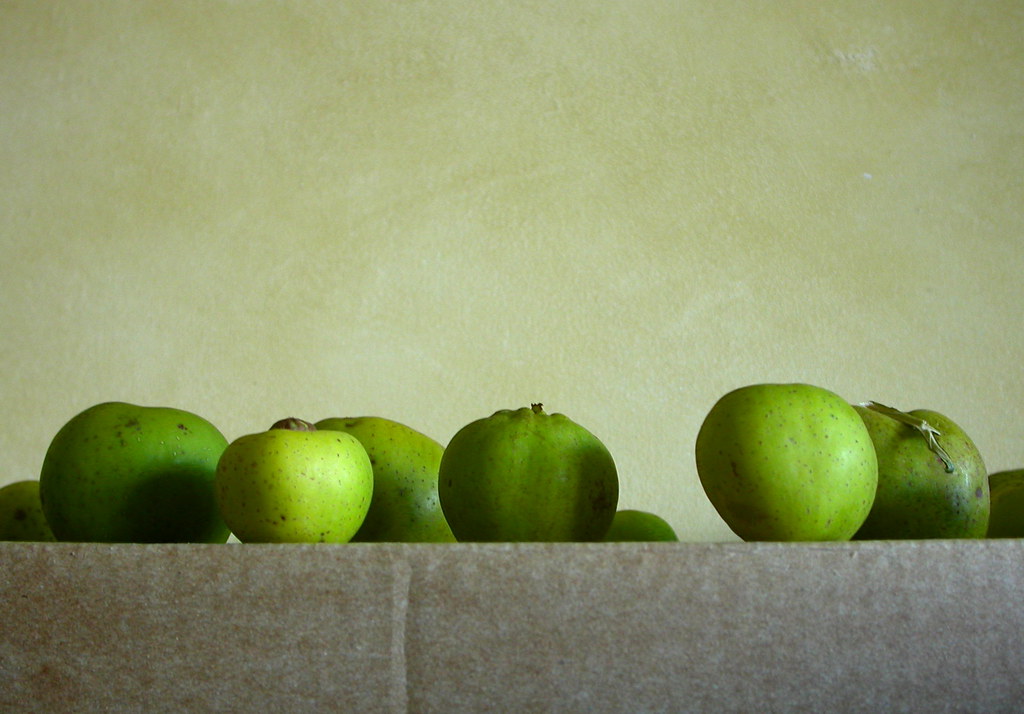Dispatches from the Monger, vol. II
 What, praytell, is a quince?
What, praytell, is a quince?
The question has plagued me for ages. Or maybe just whenever I go into the fancy produce section of Whole Foods. The quince is a foodstuff, like jicama, that I really want to incorporate into my cooking somehow, but am sort of freaked out how to go about doing so (and if anyone has any jicama recipe suggestions, let me know).
But the latest reason the quince question has come up again is because of membrillo, a quince paste that is (so they tell me) a part of Spanish cuisine.
In my Adventures in Cheesemonging, I come across many people who a) love cheese, and b) know new ways to consume cheese. And trust me, they let you know what the best way to consume it is, whether you want to know or not.
One of our most popular cheeses is a rosemary manchego - the loverlyness of the 'chego, rolled into all sorts of herby goodness. MMM. A lady came in the other day and asked me if I had tried said manchego with the membrillo and she GUSHED that it was absolutely the most amazing thing she had ever had, that's how they eat the stuff in Spain, and that I MUST try it. Fine lady, yeesh, I'll try it already! But really, I spend half my paycheck there anyway, so I picked up some manchego and membrillo and went on my merry way.
And what did I discover?
a) A quince is in fact a sort of a pear/apple hybrid.
b) Quince paste, though it may conjure up images of some gross glue-eating kindergartener, is not paste-like at all, but looks more like a firm jelly. However, it is not quite as spreadable as jelly and is more sliceable, which makes it quite convenient to slice and place on top of the 'chego or whatever else you enjoy. But if you don't like the slightly grainy texture of pears, quinces are probably not for you, nor is their paste.
c) The paste on its own? Too sweet. It definitely needs something savory to balance out the flavor. Even if you like sweet jams, this might be a little too much (on its own) for your morning toast or PB&J.
d) But the membrillo and manchego together? Delicious. The sweet slipperiness of the quince paste was perfect paired with the creamy zing of the manchego, and was even more delicious on top of a piece of raisin walnut bread. Could be breakfast (with the bread), could be dessert on its own. I've heard that Italians do a similar thing, drizzling honey over their peccorino for dessert, but I have yet to try that.
Why don't we Americans incorporate cheese into our desserts more often? Are we freaked out by combinations of the sweet & savory? Or does our gluttonous nature only allow us to think of seven-layer chocolate cakes as dessert?
Technorati Tags: Cheese, Quince, Jicama
Special thanks to Scoobymoo over at Flickr for this awesome photo of quinces.
4 comments:
I broke down one day and bought an exotic new fruit, prickly pear, because I wanted to know what it tasted like. Well, I had a vague understanding of what it would taste like based on a prickly pear margarita I had a few months prior. Anyway, it turned out that prickly pears aren't entirely edible raw because they are filled with tiny, (mostly) inedible seeds. I later found out that you're supposed to make a jam out of it. I didn't. Quinces are similar, I've heard. It took me a while to get to the point, but I got there.
Interesting...I ALSO had a prickly pear margarita recently (I guess prickly pears are the new pomegranate?) which was quite delicious. And I remember always getting prickly pear ice cream when we visited my grandparents in Arizona, but I've never seen them apart from these two instances. Now I know not to buy them (or quinces) unless I feel the need to make jam.
PS - thanks for the pic!
Funny you mention jicama-- it was in my the lastest Everyday Food magazine I got the other day, (thank you Martha Stewart corporation) as the "have you tried...?. Jicama is a root vegetable that "beneath its papery skin is a crisp, sweet white flesh that is 85-90 percent water. also known as the 'mexican potato.' Its flavor is described as a cross between a potato and an apple." It is very versatile-- often used raw in salads or as a snack. it can be steamed, boiled, mashed, or fried. Store, uncovered in a cool, dry place for up to 2 weeks. There's a recipe for jicama slaw, and jicama sticks with chili-lime dip, if it truly interests you. You know how to reach me :)
Sometimes, though, you just need the seven layer chocolate cake.
love, the carny
Post a Comment